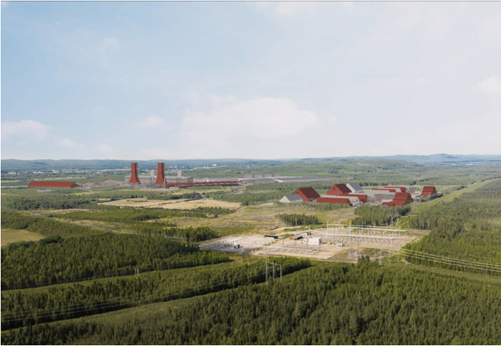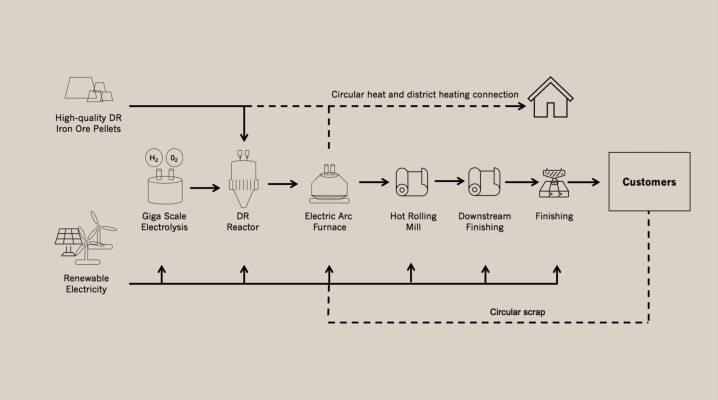Green hydrogen
H2 Green Steel - Sweden
|
Basic description H2 Green Steel, headquartered in Stockholm, was founded in 2020 by Vargas. It aims to build a large-scale green steel production facility in Boden in northern Sweden, using a combination of renewable electricity and green hydrogen, thus eliminating almost all the CO₂ emissions from the traditional steelmaking process. The company’s mandate is to decarbonise heavy industry with green hydrogen, and the construction of its first green steel plant ensures offtake for its future green hydrogen production. The project consists of a 700 MW capacity of alkaline and proton exchange membrane (PEM) electrolyser capacity, a direct reduced iron (DRI) plant with a nameplate capacity of 2.1 million tonnes (Mt) per year, a steel melt shop to combine the DRI with steel scrap, and downstream production lines to produce 2.5 Mt of finished steel products annually prior to a planned second-phase capacity expansion. Project rationale While the purpose of the company is to decarbonise heavy industry, the choice of green steel as a first application was driven by its large-scale technical and commercial readiness compared to other uses. Given its strong ties with several end customers of steel, including in the automotive sector, H2 Green Steel matches Sweden’s large resources of cheap hydropower with customer appetite for green steel. Although the green steel premium was unknown at the inception of the company, this market has started to emerge over the last couple of years. |
 |
 |
The choice to locate in Europe stems from the high risk facing the European steel industry, as free allocations within the European Union Emissions Trading System (EU-ETS) are expected to decrease in the coming years. There is also growing consumer demand for decarbonised products in Europe. The combination of a possible carbon border adjustment mechanism (CBAM) and high EU ETS prices is expected to drive up costs of producing steel via the blast furnace route. As this route emits around 2 tonnes of CO2 per tonne of steel, H2 Green Steel estimates that steel production costs will exceed EUR 100 per tonne of steel by 2031, leading to a strong increase in steel market prices. Green steel production costs will not be affected by these developments, thereby assuring sufficient margins for green steel producers. |
Governance
H2 Green Steel has a standard governance structure found in industrial sectors, with a holding company acting as an investment vehicle for equity investors and individual project companies for each new project. As the company does not envision owning future assets along the entire value chain, it could focus more on hydrogen production, possibly in vertically integrated projects, for instance with green electricity suppliers and green hydrogen off-takers.
Business model
Producing steel based on green hydrogen is more expensive than producing it via the traditional coal-based blast furnace route. Thus, the business model relies on demand from first-mover customers willing to pay a premium for green steel. In May 2022, H2 Green Steel announced that long-term contracts with volume commitments over 5 to 7 years have been signed with customers from various industries. The aggregated pre-sold volumes reached 1.5 million tonnes (Mt) per year of steel, corresponding to 60% of the plant’s future production capacity.
Moreover, in principle more than 70% of the European blast furnace capacity will need to be relined[1] over the next decade as they reach the end of their operating lifetimes. H2 Green Steel aims to minimise the production cost premium of its greenfield plants, thanks to the availability of cheap and stable renewable electricity in north Sweden. It announced a 7-year contract with Statkraft in June 2022, securing 2 terawatt-hour (TWh) per year of renewable electricity supply for its green steel facility.
Enabling market conditions and investment de-risking
Access to cheap and stable renewable electricity throughout the day and the year is the main prerequisite for the H2 Green Steel project. Building an energy-intensive plant near the large hydropower resources of Sweden, which are located far away from the country’s main electricity consumption centres, allows the electricity transport system operator to avoid massive grid investments, especially in countries having large resource potential in regions with low demand.
Steel is a globally traded good requiring large volumes of iron ore and generating large volumes of final product. Thus, access to deep-sea harbour and inbound and outbound logistics infrastructure (such as railways) will also be a decisive factor for future plants. The Boden site will be built on undeveloped land meant for industry use, yet slightly far from the main existing infrastructure. This requires ensuring the timely connection to water, energy, rail and road infrastructure besides the construction of the steel plant.
Tens of permits and licences are usually required to develop vertically integrated projects. A lean permitting process and regulatory process will be a critical factor in the country selection for future projects. Moreover, a stable economic environment and the engagement of local communities will be crucial for projects in emerging economies. As such projects are highly capital intensive, this is key to reduce country risk for domestic and international lenders. In the case of Sweden, banks and financial institutions have indicated that positive perception of the project by the local municipality and citizens is a factor in their investment decision.
Financing
H2 Green Steel is financing its first project through a combination of equity at the holding level and debt at the Boden project company level. The total investment aims for a similar gearing ratio as in typical capital-intensive industry and infrastructure projects.
H2 Green Steel equity investors are primarily interested in the holistic decarbonisation of heavy industries rather than in a single project. As the company is still young, investments will be staggered as the project progresses. In 2021, H2 Green Steel raised USD 105 million in Series A equity from various investors, including potential customers from the automotive industry. In July 2022, Hitachi Energy made an equity investment in H2 Green Steel, along with commitments to support electrical infrastructure development and to offtake the green steel product for its own manufacturing.
On the debt side, H2 Green Steel is discussing possibilities with various public and private financial institutions. A combination of debt instruments with various seniorities and guarantees will be required to finance the project.
[1] Blast furnaces operate for 20 to 25 years after which the refractory lining has to be renewed. Steel companies usually carry out refurbishing activities and upgradation in parallel of the relining process.
Related Documents